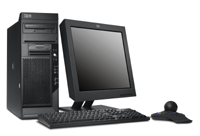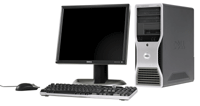In the next few weeks lots will be written about the new dual-core systems. And following that, 64-bit single-processor machines will start to make their way into the mainstream. We in the GCN Lab have already been running one of Dell's first Intel-based dual-core systems. It's too early to tell how it compares to existing PCs, because benchmark tests are still being upgraded to test dual-core CPUs, but anecdotally, the system is impressive.In the short-term, however, these next-generation systems will likely raise more questions than they answer: How many software licenses does your agency need to run a program on a dual-core system? One per core? And how do the performance benefits in your particular computing environment justify the initial cost premium for cutting-edge technology?For agencies approaching a desktop refresh cycle, now is an interesting time. The good news is that there are still many powerful, single-core desktops with proven track records and attractive price points.The GCN Lab tested a handful of these systems, ranging from workstations to high-end business desktops. Workstations typically come with high-end graphics cards and lots of memory. The desktops have more-mainstream configurations but could be upgraded to handle technical or 3-D computing. The Gateway E-4300 6-Bay, for instance, is a powerful desktop that could easily and inexpensively be turned into a low-end workstation with the right video card.A couple of the systems we tested'the HP DX5150 and the IBM ItelliStation Z Pro'are ready for 64-bit computing when the software appears. Those two were also the only systems not to run on an Intel Pentium 4 processor. The former uses an Athlon 64, the latter an Intel Xeon. Others, such as the Dell Precision 380, could be upgraded for 64-bit support.For agencies that have desktop computing needs now, we recommend two of these computers: the Dell Precision 380 for workstation computing, and the Gateway E-4300 6-Bay for destkop computing. Both offer good performance at a reasonable price. Stay tuned for GCN Lab reviews of dual-core and 64-bit platforms.[IMGCAP(2)] Fast, affordable, good graphics Awkward form factor A A- A+Value: A-The Precision 380, with its 2.8GHz Pentium 4 processors and 1G of DDR-2 RAM, has power for demanding productivity applications plus some workstation-class graphics. The system averaged 9,190 on the Alterion application benchmarks, almost double the score of the slowest PC in our review and well above average for all desktop systems we've tested.Often in this class of desktop, high performance is imperceptible in everyday tasks. But we could tell the Precision was a responsive system from the get-go. Installing and uninstalling applications for our benchmark tests took mere seconds, compared with minutes on competing systems. Likewise, the boot-up and shutdown processes were faster than usual.Dell saved money by going to a smaller 40G serial ATA hard drive without RAID capabilities and instead boosting the graphics card to an ATI FireGL V3100 with 128M of dedicated video RAM. Good move. The bundled card is a workhorse and could readily handle agencies' geographic information systems or low-end computer-aided design.Even with the video card upgrade, the Precision 380 costs only $1,460. Depending on when you're shopping, you could get an even better deal. During testing, we found discounts that could bring our configuration all the way down to $868.If we had an issue with the Precision, it had to do with its design. The system takes advantage of the new BTX-style motherboard, which shifts the board's position to increase air circulation and decrease cooling-equipment noise. But we were dismayed by Dell's switch from the clamshell chassis design. Instead of easy, briefcase-like access to the internal components, the Precision's insides are accessed through a side panel that unlocks with a lever on top of the tower. It's easy to open this chassis, but closing it is another matter.Despite this minor drawback, the Precision is a well-built workstation with enough power to handle more than the Microsoft Office suite. If your desktop users have higher-end computing needs, this Dell line is worth a look.Dell Inc., Round Rock, Texas, 800-999-3355, Huge hard drive, six expansion bays Louder-than-average fan noise A- A- A- B+Not a traditional workstation per se, the Gateway E-4300 6-Bay is still a powerful desktop with expansion room to support high-end applications. Performance-wise, the 2.8GHz, Pentium 4-based system is among the fastest we tested, with an Alterion benchmark score of 8,058. And that's while running an integrated Intel graphics accelerator and just 512M of DDR-2 memory. If you installed a workstation-class video card in one of the E-4300's two PCI Express slots and bumped up the RAM to 1G, you'd have a system capable of handling your most demanding programs.Our test system cost $1,303, which included a massive 145G, 7,200-rpm serial ATA hard drive. You could save money on storage, put it toward the performance components and still have a very affordable machine. As the name implies, there are enough drive bays to add storage later.The mid-size Gateway has six USB 2.0 ports (two in front) and an impressive three FireWire ports (also two in front) for additional fast peripherals. The system we tested came with a floppy drive and a DVD/CD-R combo drive.Unfortunately, like other power desktops we've tested, the E-4300 is downright noisy. Inside, we found a unique cooling system in which the processor fan is encased in a tube that vents out the side of the case. The processor cooling system is completely separate from the main motherboard-cooling fan. It keeps the CPU humming along quite efficiently (and, as we saw, aids performance), but it also adds to the noise.[IMGCAP(3)]Still, this is a good power desktop at a reasonable price. Take advantage of its upgrade potential, and you're not likely to be disappointed.Gateway Inc., Irvine, Calif., 605-232-2000, Great value, good performance Cramped minitower, no FireWire support B+ B B A-Is it a workstation? Not exactly. Is it a fast, affordable desktop capable of handling upcoming 64-bit software? Yes. Toss a high-end video card into one of its PCI Express slots, and the HP DX5150, like the Dell Precision 380, could be both.HP was the only company to send us a performance desktop that used an Advanced Micro Devices CPU. The AMD Athlon 64 3500+ processor helps keep the overall system price down (sans monitor, a mere $871 for government buyers) without cutting performance corners. The DX5150's Alterion benchmark score of 7,030 isn't the best we've seen, in part because the system came with an integrated ATI Radeon 9600 video adapter, but it is better than the company's own high-end Pentium 4-based workstation and IBM's Xeon-based IntelliStation (see below). And that integrated video controller can drive two monitors'one analog and one digital'for specialized government applications.Our test system also came with 512M of memory, an 80G serial ATA hard drive and eight USB 2.0 ports (two in front) for external peripherals. We were a little surprised to see HP left out a FireWire port, though.The system's minitower case was truly mini and, frankly, a chore to remove. Once inside, we found, not surprisingly, a cramped interior, although HP did a great job of keeping cables out of the way.For now, the DX5150 ships with Windows XP Pro, but soon you will be able to get it with Windows XP Pro x64 Edition (you can download the 550M beta from Microsoft today). For agencies in a desktop refresh cycle, it could offer superior investment protection.Hewlett-Packard Co., Palo Alto, Calif., 800-752-0900, Good chassis design Slow processor performance B- B C+ BThe HP XW4300 is a Pentium-based workstation with perhaps a better design than the Dell Precision 380, but none of its the workstation-class performance. It averaged just 5,714 on the Alterion benchmarks, worse than we've seen from sluggish notebooks.Our test system came with a 2.8GHz processor, 1G of DDR-2 memory and a roomy 80G hard drive. But it also had a comparatively low-end Nvidia Quadro NVS 280 video card with only 64M of dedicated video RAM. For actual graphical or technical computing, you'll want an upgraded card.Interestingly, not all of the performance issues can be attributed to system components. During testing, we noticed the processor did not utilize a heat cone, which would normally deflect ambient heat away from other internal components and focus cool air on the processor. When we ran the benchmarks first thing in the morning, the XW4300 scored at its peak. But later in the day, after it had been running for a while, the score dropped several hundred points due to overheating. A perfectly cooled system still wouldn't have performed top-of-the-class, but it would have been better.That said, we were comfortable using and navigating the XW4300. It has eight USB 2.0 ports (two in front) and a front-mounted FireWire port. A removable side panel made it easy to access the motherboard, which was largely unobstructed (good thing, if you want to upgrade that video card).As workstations go, the XW4300 is relatively affordable at $1,289. But with its performance issues, you don't get a lot of bang for those bucks.Hewlett-Packard Co., Palo Alto, Calif., 800-752-0900, www.hp.com Highly expandable, lots of RAM Expensive relative to performance C+ B+ B- CThe IntelliStation Z Pro is a true workstation, forgoing the Intel Pentium processor for a 3.4GHz Xeon backed by 2G of DDR-2 RAM. As such, however, you wouldn't want to use it for everyday computing.Whereas Dell's workstation is quite flexible'excelling on productivity apps while aimed more at high-end programs'IBM's is not. It scored just 6,427 on the Alterion benchmark tests, which arguably was not able to fully gauge the system's ability to handle CAD or other 3-D applications. Still, if you're looking for a dedicated technical workstation, you'll gladly accept an RFP response from IBM.The IntelliStation's Xeon chip includes Intel's Extended Memory 64 Technology supporting current and future 64-bit programs. Our unit also came with an 80G, 7,200-rpm hard drive and a 128M NVidia Quadro FX1300 video card (agencies could upgrade to a 256M ATI V7100 for better performance). It has one FireWire and two USB ports up front, and it's roomy in case you ever need to get inside to upgrade it.Unlike the quiet-running Dell Precision, though, our IntelliStation was flat-out noisy. When we first booted the system, it sounded like a vacuum cleaner going full blast. We talked to an IBM engineer who said noise was a problem with early builds of the IntelliStation line that has since been fixed.In short, you should have very specific technical computing needs to consider the IntelliStation Z Pro. And at a whopping $3,519, you'd better have deep pockets, too. At that price, the IntelliStation should also be able to crunch spreadsheets better than our tests indicate it can.IBM Corp., Armonk, N.Y., 888-839-9289,
IBM's IntelliStation Z Pro is pricey and features a Xeon processor that actually lags other CPUs in application performance.
The Dell Precision 380 is a fast workstation as-is, but it's also available in 64-bit and dual-core models.
The Gateway E-4300 6-Bay makes for a powerful business desktop with room to grow.









